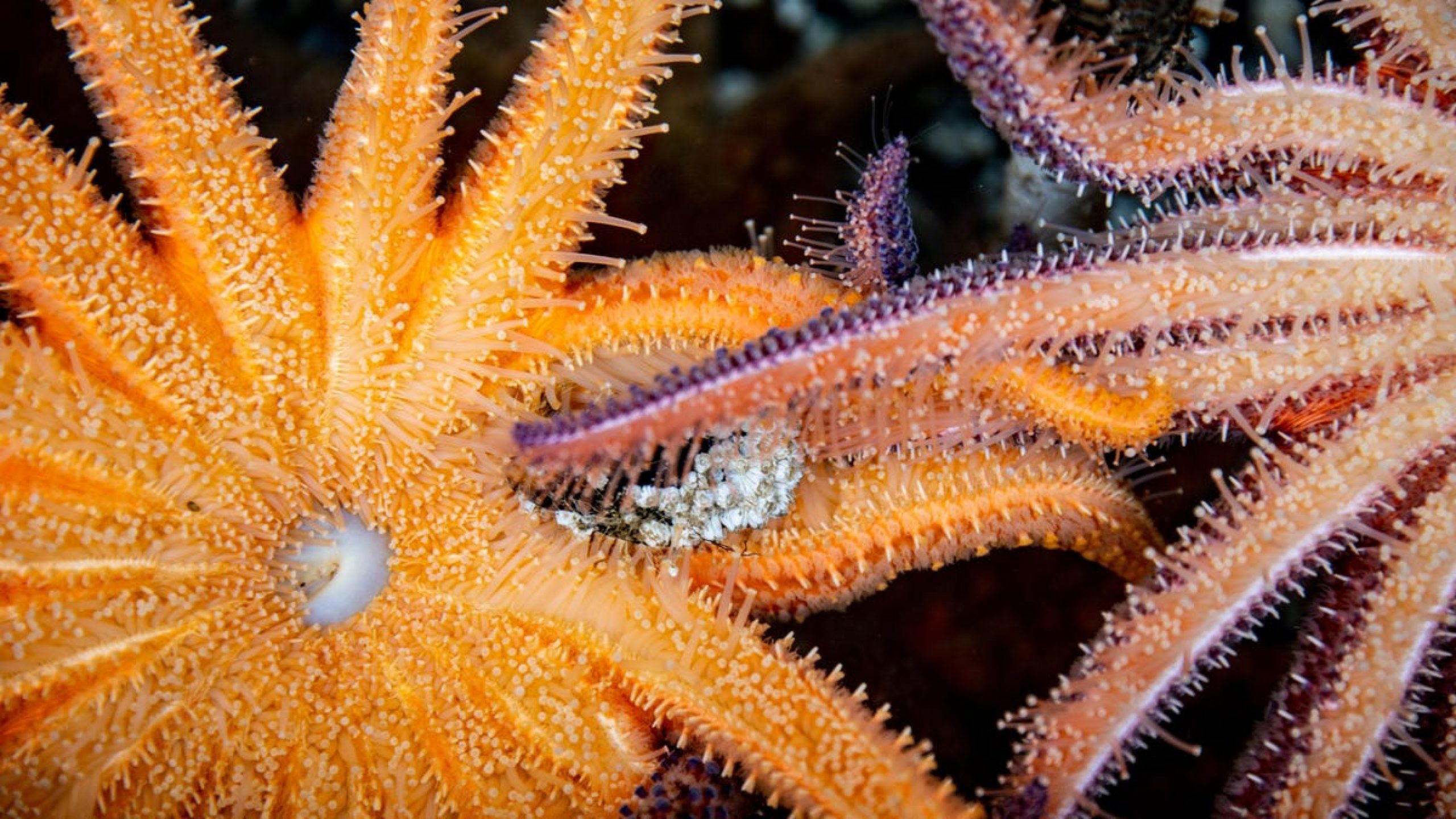Scientists Are Racing to Save These Sea Stars From Extinction
Since 2013, a disease exacerbated by overheating oceans has been decimating sea star populations, especially those of one particularly striking variety: sunflower sea stars. Over the course of three years, the illness killed off nearly 91% of the sunflower species’ global population. Now, scientists are fighting to restore the beautiful creatures before it’s too late. That could boost the health of kelp forests, which would help wildlife and us in addressing the climate crisis.
Sunflower sea stars are the biggest starfish on the planet: They can measure up to 3 feet (0.9 meters) across. They’re also the fastest variety, using their 24 arms to race across the seafloor at a rate of one yard (0.9 meters) per minute. The creatures come in a rainbow of different colors and a variety of patterns. Their forms take on deep browns and purples, sunny oranges and yellows, and pink bodies with lavender extremities. The species was once abundant from Alaska to Southern California, but thanks to an outbreak of the mysterious ocean-borne illness known as sea star wasting syndrome, they all but disappeared.
“They are the first ever listed endangered sea star,” Jason Hoden, a senior scientist at Friday Harbor Labs who is running the sunflower sea star breeding project, said.
There are currently none of these creatures left in Californian and Mexican waters, and though populations still exist in British Columbia and Alaska, as well to a more limited extent off the coast of Oregon and Washington, numbers are dwindling.
G/O Media may get a commission
The 2013 outbreak of sea star wasting syndrome wasn’t the first—die-offs also occurred in the 1970s, 1980s, and 1990s—but it was by far the most severe and prolonged. In a 2019 paper led by Drew Harvell, professor emeritus at Cornell University and resident researcher at Friday Harbor Labs, authors found an association between the epidemic’s intensity and marine heat waves.
“The years of the sea star wasting epidemic were also the years of a dangerously hot marine heat wave,” Harvell wrote in an email. Indeed, from 2013 to 2016, a phenomenon known as “the blob” supercharged ocean heat. The animals’ demise has done serious damage to marine ecosystems.
“Like sharks and wolves, sunflower stars are top predators in their own ecosystems, which range from the intertidal to deeper waters,” said Hodin. “Predators help maintain balance in ecosystems; when they are removed by overfishing, habitat loss or in this case a disease, there are dramatic cascading effects.”
Sunflower sea stars are the key predators of sea urchins, which eat kelp. But without the stars around to keep urchin populations in check, the number of urchins have grown out of control. All those urchins have been chomping down tons of kelp.
“In California, we’ve seen major kelp declines that coincided with the sunflower star disappearance and the explosion of kelp-eating urchins,” Hodin said.
That’s bad news for the climate crisis since kelp forests sequester carbon. Research has shown seaweed can sequester 1,500 tons of carbon dioxide per 0.4 square miles (1 square kilometer) of ocean. Preserving existing kelp forests could help address climate change as well as provide habitat for wildlife from otters to fish.
Hodin’s project started in March 2019 and is a joint venture between the University of Washington and the Nature Conservancy. To revive sunflower sea star populations for the project, Hodin and his team regularly go out collecting specimens from existing populations and bring them into the lab. The stars spawn once a year and the scientists raise their larvae—which when born, are no bigger than poppy seeds—for up to four months in gallon-sized glass jars.
When the sea stars get a little bigger, the researchers put them in larger netted cages, which Hodin said is the most difficult part of the process since they have to try out different foods and substrates—the base of soils and other organic matter on which an organisms live—to try to optimize their growth. Since sunflower sea stars have never been bred in a lab before, scientists know little about what they need to thrive.
“We have no idea what they eat or what conditions they need during those early stages before they can start eating as adults do,” said Hodin.
Eventually, the researchers will release the animals into the wild, but they’re not exactly sure when yet. Hodin said the best time may be when they reach the size of a tennis ball, but they’re doing more research to find out for sure. Once released, scientists also aren’t exactly sure how they’ll fare.
“I regret we cannot say yet how or if they will adapt to warming,” said Harvell. That’s especially true because as she noted, the deadly disease is still out there and could claim more victims.
Hodin said scientists have reason to be hopeful that their reintroduction will be successful, though. To see if the tiny larvae can withstand hotter seas, the scientists are subjecting them to fluctuations in water temperatures in the lab. So far, the baby sea stars are doing well.
“We have seen that the larvae are very robust to temperature changes, which is good and bodes well for their survival in a warming ocean,” said Hodin. “It’s more difficult for us to manipulate the temperature that the juveniles experience, but doing so is a plan for next year.”
At that point, the team also hopes to know far more about how to best prepare the sea stars for life out of captivity, and how to support them so they continue to breed while they’re out there. Let’s hope the little guys fare OK and become big, gorgeous sunflower sea stars, which could make them a much-needed boon for kelp and the climate.

